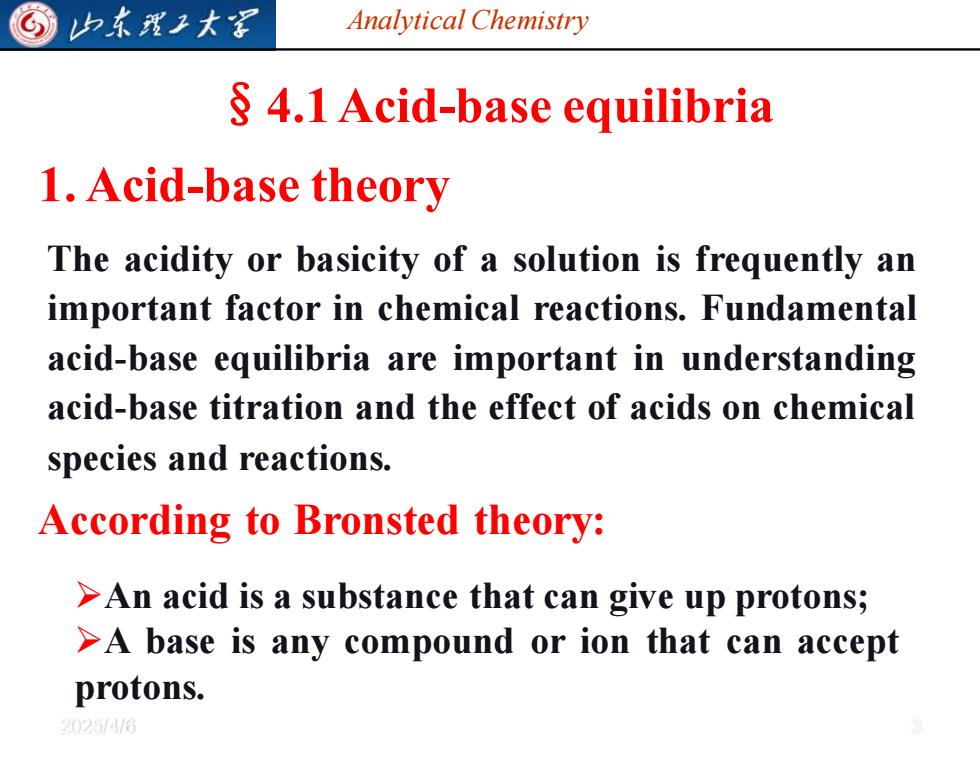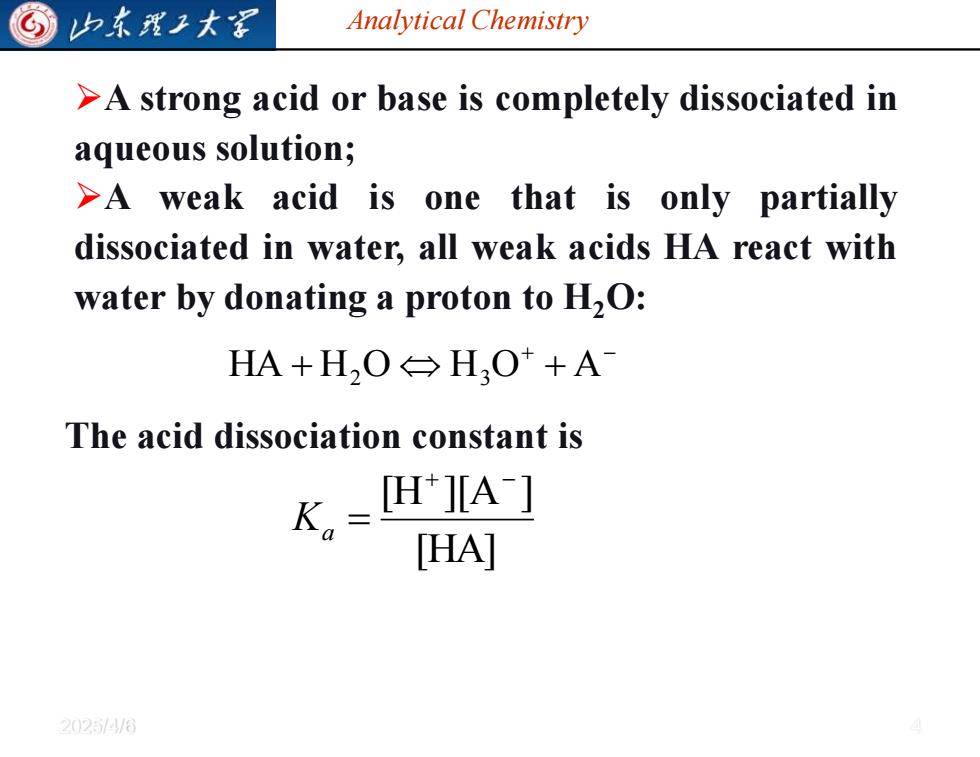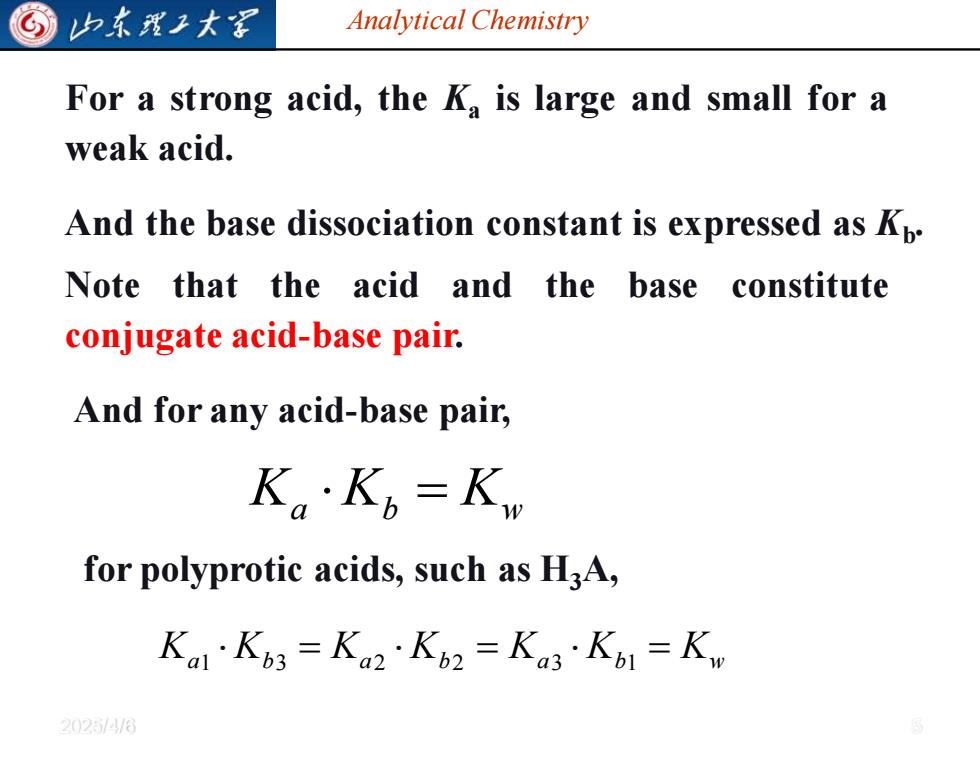
G 归东理工大军 Analytical Chemistry >To master the requirements of the titration error; To know about the classical applications and calculation of all kinds of titrations. 20254/6
Analytical Chemistry 2025/4/6 2 ➢To master the requirements of the titration error; ➢ To know about the classical applications and calculation of all kinds of titrations

山东理子大军 Analytical Chemistry 4.1 Acid-base equilibria 1.Acid-base theory The acidity or basicity of a solution is frequently an important factor in chemical reactions.Fundamental acid-base equilibria are important in understanding acid-base titration and the effect of acids on chemical species and reactions. According to Bronsted theory: >An acid is a substance that can give up protons; >A base is any compound or ion that can accept protons. 202514/
Analytical Chemistry 2025/4/6 3 §4.1 Acid-base equilibria 1. Acid-base theory The acidity or basicity of a solution is frequently an important factor in chemical reactions. Fundamental acid-base equilibria are important in understanding acid-base titration and the effect of acids on chemical species and reactions. According to Bronsted theory: ➢An acid is a substance that can give up protons; ➢A base is any compound or ion that can accept protons

G 归东理2大军 Analytical Chemistry >A strong acid or base is completely dissociated in aqueous solution; >A weak acid is one that is only partially dissociated in water,all weak acids HA react with water by donating a proton to H2O: HA+H,O→HO++A The acid dissociation constant is K,=H*4】 HA] 20254/6
Analytical Chemistry 2025/4/6 4 ➢A strong acid or base is completely dissociated in aqueous solution; ➢A weak acid is one that is only partially dissociated in water, all weak acids HA react with water by donating a proton to H2O: + − HA + H2 O H3 O + A The acid dissociation constant is [HA] [H ][A ] + − Ka =

归东理工大买 Analytical Chemistry For a strong acid,the K,is large and small for a weak acid. And the base dissociation constant is expressed as Kp. Note that the acid and the base constitute conjugate acid-base pair. And for any acid-base pair, Ka·Kb=Kw for polyprotic acids,such as H3A, Ka1K3=Ka2·K2=Ka3K1=K。 20254/6
Analytical Chemistry 2025/4/6 5 For a strong acid, the Ka is large and small for a weak acid. And the base dissociation constant is expressed as Kb . Note that the acid and the base constitute conjugate acid-base pair. And for any acid-base pair, Ka Kb = Kw for polyprotic acids, such as H3A, Ka Kb Ka Kb Ka Kb = Kw = = 1 3 2 2 3 1

G 归东理2大军 Analytical Chemistry 2.Proton balance equation Acid-base reactions essentially involve the proton transferring process. And the number of protons that the acid gives up is always equal to that the base accepts. For example,in a NaCO3 solution,the proton balance equation is: [H]+HCO3]+2H2C03]=[OH] For c mol/LNaH2PO solution, PBE [H]+(H3PO4)=(HPO42-)+2P043-)+(OH) 20254/6
Analytical Chemistry 2025/4/6 6 2. Proton balance equation Acid-base reactions essentially involve the proton transferring process. And the number of protons that the acid gives up is always equal to that the base accepts. For example, in a Na2CO3 solution, the proton balance equation is: [H ] [HCO ] 2[H CO ] [OH ] - 2 3 - + 3 + = + For c mol/LNaH2PO4 solution, PBE [H+ ]+ 〔H3PO4〕 = 〔HPO4 2-〕+ 2[PO4 3-〕 +〔OH-〕